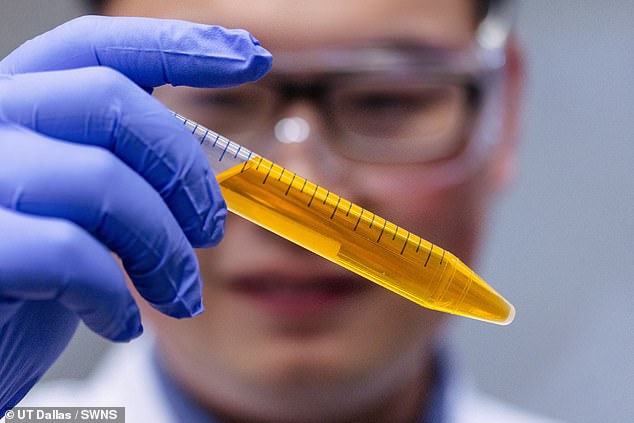E-number in cornflakes and energy drinks can make your skin TRANSPARENT, scientists discover ‘magic trick’ with orange food dye
A revolutionary new technique uses food coloring to create a ‘window’ into the body by making the skin transparent.
Researchers made the skin on the skulls and abdomens of living mice transparent by applying a mixture of water and a common yellow food dye called Tartrazine, which is commonly found in cereal, candy, energy drinks, chicken broth and potato chips.
The groundbreaking technique, described in the journal Science, offers doctors a new way to view organs inside a body by making the overlying tissues transparent to visible light.
It has not yet been tested on humans as a food coloring, because food coloring can be harmful.
But the process has been shown to be reversible in animal tests, and scientists say it could eventually be used for a variety of medical applications — from detecting injuries to monitoring digestive disorders and identifying cancer.
Dr Guosong Hong from Stanford University in the US, who led the research, said: ‘In the future, this technology could make veins more visible for blood sampling, make tattoo removal using lasers easier, and aid in the early detection and treatment of cancer.
Tartrazine is commonly found in energy drinks (File Image)

It is also found in cornflakes (File image)

Dr Guosong Hong (pictured) said: ‘In the future, this technology could make veins more visible for blood sampling, make tattoo removal using lasers easier, or aid in the early detection and treatment of cancer.’
“For example, certain therapies use lasers to eliminate cancer cells and precancerous cells, but they are limited to areas close to the skin’s surface. This technique could potentially improve that light penetration.”
To master the new technique, the researchers developed a way to predict how light interacts with colored biological tissues.
The predictions required a deep understanding of light scattering, as well as the process of refraction, in which light changes speed and bends as it travels from one material to another.
The research team explained that scattering is the reason we can’t see through our bodies. Fats, fluids in cells, proteins and other materials each have a different refractive index, a property that determines how much an incoming light wave will bend.
In most tissues, these materials are packed close together, so their different refractive indices cause light to scatter as it passes through.
It is the scattering effect that our eyes interpret as opaque, colored, biological materials.
The researchers realized that if they wanted to make biological material transparent, they had to find a way to match the different refractive indices so that light could travel through it unhindered.

The chemical is commonly found in soft drinks
Building on fundamental insights from optics, the researchers concluded that the dyes most effective at absorbing light can also be “very effective” at guiding light evenly across a wide range of refractive indices.
One dye that the researchers predicted would be particularly effective was tartrazine, the food dye better known as FD&C Yellow 5.
When tartrazine molecules were dissolved in water and incorporated into tissues, they were found to have a perfect structure that matched the refractive indices and prevented scattering of light, resulting in transparency.
The research team first tested the technique on thin slices of chicken fillet.
As the tartrazine concentration increased, the refractive index of the fluid in the muscle cells increased until it became equal to the refractive index of the muscle proteins. The slice became transparent.
The researchers then gently rubbed a temporary tartrazine solution on the mice.
First, they applied the solution to the scalp, making the skin transparent and revealing the blood vessels crisscrossing the brain.
They then applied the solution to the abdomen. Within a few minutes the symptoms disappeared and there were contractions of the intestines and movements caused by heartbeat and breathing.
After the dye was rinsed off, the tissues quickly returned to normal appearance.

One dye that the researchers predicted would be particularly effective was tartrazine, the food coloring better known as FD&C Yellow 5 (File image)

File photo of a young boy drinking an orange soda at a beach bar in the late afternoon light
The tartrazine did not appear to have any long-term effects and any excess was excreted in the waste products within 48 hours.
The researchers suspect that injecting the dye could lead to even deeper insights into organisms, with implications for both biology and medicine.
Lead author of the study, Dr. Zihao Ou, assistant professor of physics at the University of Texas at Dallas, said: ‘We combined the yellow dye, a molecule that absorbs most light, especially blue and ultraviolet light, with the skin, a scattering medium.
These two things individually block most of the light.
“But when we put them together, we were able to create transparency in the mouse skin.”
Dr. Ou, who conducted the research while a postdoctoral researcher at Stanford University, added: ‘For those who understand the fundamental physics behind this, it makes sense. But if you’re not familiar with it, it looks like a magic trick.
It takes a few minutes for the transparency to appear.
‘It is comparable to the way a face cream or mask works: the time it takes depends on how quickly the molecules penetrate the skin.
‘It is important that the dye is biocompatible, that is, safe for living organisms.
‘Plus, it’s very cheap and efficient; we only need very little of it to make it work.’
The researchers have not yet tested the process on humans. Human skin is about ten times thicker than that of mice.
According to Dr. Ou, it is not yet clear what dosage of dye or method of administration is needed to penetrate the full thickness.
He said: ‘In human medicine we now have ultrasound to look deeper into the living body.
‘Many medical diagnostic platforms are very expensive and inaccessible to a wide audience. Platforms based on our technology should not be.
‘Our research group is largely made up of academics, so one of the first things we thought about when we saw the results of our experiments was how this could improve biomedical research.
‘Optical equipment, such as the microscope, is not used directly to study living people or animals, because light cannot pass through living tissue.
“But now that we can make tissue transparent, we can look at more detailed dynamics. It will completely revolutionize existing optical research in biology.”
